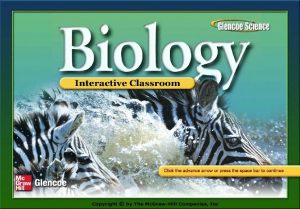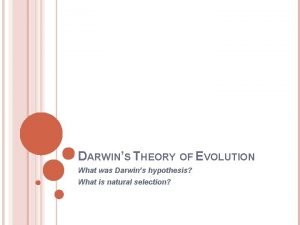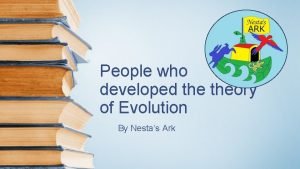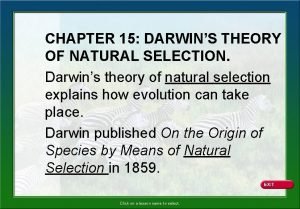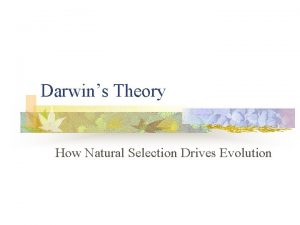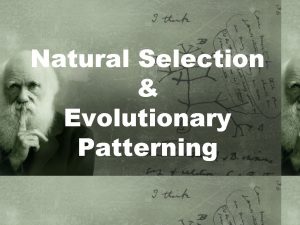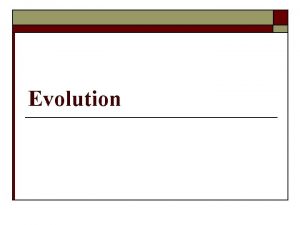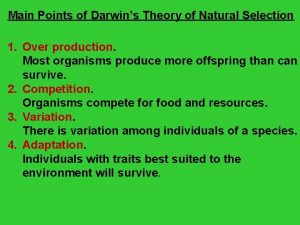15 1 Darwins Theory of Natural Selection Main








- Slides: 8

15. 1 Darwin’s Theory of Natural Selection Main idea: Charles Darwin developed a theory of evolution based on natural selection Objectives n Discuss the evidence that convinced Darwin that species could change over time. n List the four principles of natural selection. n Show natural selection could change a population New Vocabulary n Selective breeding, Artificial selection, Natural selection, Evolution

Developing the Theory of Natural Selection Charles Darwin boarded the HMS Beagle in 1831. Most believed the world was about 6, 000 years old. During the ship’s five year voyage, Darwin made extensive collections of rocks, fossils, plants and animals. He also read Charles Lyell’s Principles of Geology – a book proposing the Earth was millions of years old.

Developing the Theory of Natural Selection HMS Beagle In 1835, the Beagle arrived in the Galapagos Islands off the coast of South America. Darwin began to collect mockingbirds, finches, and other animals on the four islands. He noticed that the different islands seemed to have their own, slightly different varieties of animals.

Developing the Theory of Natural Selection Galápagos Islands Almost every specimen that Darwin had collected on the islands was new to European scientists. Darwin suspected populations from the mainland changed after reaching the Galápagos.

Developing the Theory of Natural Selection Darwin hypothesized that new species could appear gradually through small changes in ancestral species. Darwin inferred that if humans could change species by artificial selection (selective breeding), then perhaps the same process could work in nature.

Developing the Theory of Natural Selection Darwin called his theory Natural Selection He reasoned that, given enough time, natural selection could modify a population enough to produce a new species.

Basic Principles of Natural Selection Principle Example 1. Variation: Individuals in a population differ from one another. Some sunflowers are taller than others. 2. Heritability: Variations are inherited from parents. Tall sunflowers produce tall sunflowers, and short sunflowers produce short sunflowers. 3. Overproduction: Animals have more young than can survive on the available resources. Each sunflower has hundred of seeds, most of which will not germinate. 4. Reproductive Advantage: Variations that increase reproductive success will be more common in the next generation. If short sunflowers are more successful, they will be able to produce more short sunflowers.

The Origin of Species Darwin published On the Origin of Species by Means of Natural Selection in 1859. Today, biologists use the term evolution to define changes in groups of organisms through time. Darwin’s theory of natural selection is NOT the same as evolution. Natural selection is a means of explaining HOW evolution works.
 Chapter 15 section 1 darwins theory of natural selection
Chapter 15 section 1 darwins theory of natural selection Chapter 17 darwin's theory of evolution
Chapter 17 darwin's theory of evolution Darwin's hypothesis
Darwin's hypothesis Similarities
Similarities Natural selection vs artificial selection
Natural selection vs artificial selection Difference between continuous and discontinuous variation
Difference between continuous and discontinuous variation Disruptive selevtion
Disruptive selevtion Natural selection vs artificial selection
Natural selection vs artificial selection Theory of natural selection
Theory of natural selection
